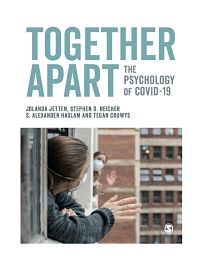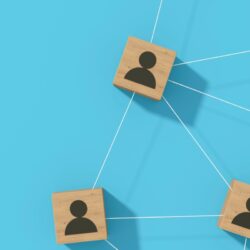Risk Perception Amid COVID: An Excerpt from ‘Together Apart’
Patient A1.1, who was then still experiencing mild respiratory symptoms, attended a birthday party with nine other people. They hugged and shared food at the three-hour party. Seven of the attendees soon became ill. Within about a week of the onset of symptoms, the condition of [patient A1.1] deteriorated. The person was hospitalized, put on a ventilator and subsequently died… Meanwhile, two of the birthday party attendees became critically ill and were put on ventilators. Both died.(Cha, 2020)
The behaviours which cause — or prevent — the spread of COVID-19 are ‘micro’ behaviours that people engage in dozens of times every day: touching one’s face, shaking hands, physically distancing from other customers in the supermarket, or visiting an ageing relative. These behaviours ultimately determined whether a community managed to ‘flatten the curve’ and become one of the success stories in the initial COVID-19 response, or alternatively, experienced uncontrolled spread and ensuing tragedy. However, there is rarely complete alignment between the perceived risk of these behaviours and their actual risk. This complicates the goal of minimising those interactions that are high risk for transmission (e.g., large intergenerational family gatherings with shared food) without banning those activities that are unlikely to pose a risk (e.g., going for a solo run on a quiet beach).
Shared group membership attenuates risk perception and increases health risk taking
As outlined in Section A, when people see themselves and others through the lens of social identities, their behaviour, emotions, and thoughts are fundamentally shaped by these social identities. It should come as no surprise that one of the things affected by shared group membership is our perception of risk. The first evidence that social relationships affect health risk taking was documented by public health campaigners attempting to slow the spread of sexually transmitted diseases, particularly HIV. Researchers found that people were far less likely to take precautions (and were therefore far more likely to contract STDs) when their sexual partner was someone they trusted and had a close relationship with (Hammer et al., 1996). Similarly, needle sharing is not a behaviour that occurs in a vacuum — instead it is most likely to occur in small, tight-knit groups of users among whom there is reciprocal trust (Unger et al., 2006).

The evidence that these processes are driven by social identity has been gathered primarily in the context of mass gatherings. For decades, mass gatherings have been seen as major sites for the spread of contagious disease (Tam et al., 2012). Indeed, pilgrimages to Qom in Iran have been implicated in the global spread of COVID-19 (Memish et al., 2020). Mass gatherings also present heightened health risks associated with poor sanitation, hardships such as extreme weather and noise, and limited capacity for help in emergencies, because emergency services often have great difficulty accessing crowded areas (Ranse et al., 2017). However, attendees typically do not perceive mass gatherings as risky places. This is because people use shared group membership with others as a heuristic, or proxy indicator, for safety. Social identity researchers have found that the more strongly people identify with fellow attendees at a mass gathering, the more likely they are to report comfort and well-being in these environments (Cruwys et al., 2019; Novelli et al., 2010) and the less likely they are to be disturbed by the risks posed by the crowd (Pandey et al., 2013).
Experimental evidence also speaks to the capacity for shared group membership to attenuate perceptions of disease risk. In one ‘minimal group’ study, 123 participants were randomly assigned to a red group or a green group, and asked to finish building a Lego model commenced by a previous participant. They encountered dirty tissues in the shared workspace that were attributed to a previous participant with a cold. Participants showed greater concern about the risk to their own health when the previous participant was identified as an outgroup member than when they were an ingroup member (Cruwys et al., 2020). Critically for the COVID-19 context, these findings are not specific to perception but also extend to actual behaviour. For example, Firing and Laberg (2012) found that military officers were more likely to participate in a collective and risky leap into ocean waters when they identified strongly with their fellow officers. Indeed, social factors more strongly predicted this behaviour than officers’ personal characteristics (e.g., their impulsivity).
In summary, social identity processes will have a dual role in shaping risk perception during the COVID-19 pandemic. On the one hand, they can support accurate assessment of risk (e.g., leading people to not sit near a stranger on public transport). On the other, they can also compromise them (e.g., so that people share a meal with friends or hug a relative).
Shared group membership facilitates trust and attenuates disgust
Why do we see this link between shared group membership and willingness to engage in risky health behaviours? Studies have found evidence for two pathways: a cognitive pathway related to trust and an emotional pathway related to disgust. Let us look at these in turn.
The link between trust and risk taking is well-established. For example, a series of experimental studies using investment and gambling games found that people will take more risks (in this case, invest more money) when the outcomes of a game are controlled by someone they trust (e.g., Cook et al., 2014). Indeed, even when group membership was randomly determined on the basis of arbitrary criteria, people were still more likely to trust ingroup members than outgroup members to take care of their interests (Tanis & Postmes, 2005). These processes also play a role in risk taking that can lead to disease transmission. In one study with over 350 participants, people were asked to consider a scenario in which their work colleague, without asking permission, took a sip from the participant’s own cup of coffee (Cruwys et al., 2020). The work colleague was described as either sharing nationality with the participant or as being a foreigner. Participants trusted the colleague less in the latter case — perceiving there to be a greater risk to their health after sharing drinks. Consistent with a social identity interpretation of these effects, this effect was most pronounced among people who strongly identified with their nation.
Disgust constitutes a second pathway through which shared group membership can affect health-risk perceptions and behaviour. Although disgust might be unpleasant, it is an adaptive emotion that specifically evolved to motivate us to avoid things likely to pose a risk of disease: spoiled food, waste products, and bodily secretions (Curtis et al., 2011). Extending this to group contexts, on evolutionary grounds, one can predict that such disgust response extends towards outgroup members to protect us from new diseases (Murray & Schaller, 2016). That is, for much of human history, different groups interacted rarely and contact with new groups was sometimes devastating, as infectious diseases spread rapidly among immunologically naïve populations. For example, the colonisation of the Americas likely enabled the spread of syphilis through Europe and even more devastatingly, the spread of smallpox through North America (Ramenofsky, 2003).
While disgust is heightened for outgroup members, there is evidence that it is lower for those who we see as ingroup members. Returning to the context of mass gatherings, two studies by Hult Khazaie and Khan (2019) found that people who felt a sense of shared identity with fellow attendees felt less disgust towards these ingroup members, and less vulnerable to the risk of disease. These findings have been corroborated by experimental evidence. For instance, one study found that participants who were asked to handle a sweaty t-shirt felt more disgust and walked faster to clean their hands when the t-shirt belonged to an outgroup member than when it belonged to an ingroup member (Reicher et al., 2016).
Integrating group processes into public health messaging will improve their effectiveness
In a COVID-19 context, these various processes can have ironic effects. Because distrust and disgust are lower for ingroup than outgroup members, people might be more likely to engage in behaviours that risk disease transmission specifically when interacting with people who they perceive to be ingroup members. It has been clear from the beginning of the COVID-19 outbreak that most transmission occurs within the context of families or other communal gatherings (e.g., birthday parties; weddings), rather than through contact with strangers or foreigners (Cha, 2020). For this reason, ‘othering’ the disease, as a problem caused or experienced by outgroups (see also Chapters 7 and 19) misrepresents who the most likely vectors are — those with whom we feel safe. This also leads us to take risks that we otherwise would not. Stark evidence for this is provided by Australian data on people’s compliance with recommended physical distancing measures (collected in April 2020; Liddy et al., 2020). While an impressive 84% of people avoided strangers on public transport, only 54% of people avoided colleagues or their workplace. A mere 13% of people reduced physical contact with those in their home.
Public health messaging needs to take account of these social identity dynamics. In particular, it needs to engage with the fact that people’s desire to keep ingroup members safe is at odds with the fact that they are slow to recognise the risks that ingroup members pose to health. A key way to do this is by emphasising that physical distance is an act of care towards other group members, not a sign of mistrust.
Explore the section of Together Apart on social (dis)connectedness
Group Threat and COVID| Katharine H. Greenaway
Risk Perception Amid COVID | Tegan Cruwys
Social Isolation Amid COVID | Sarah V. Bentley



























































































